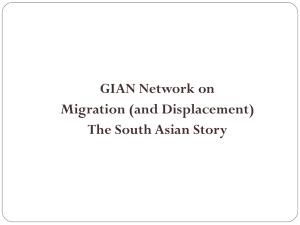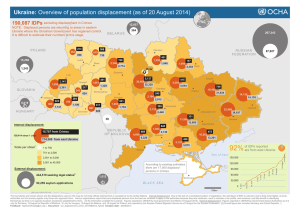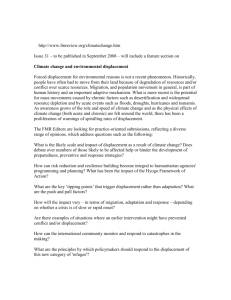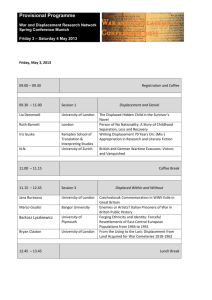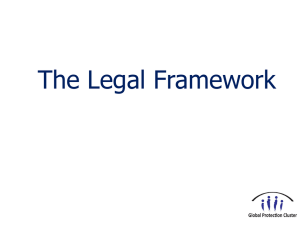Climate Change-related Displacement and the - sid
advertisement
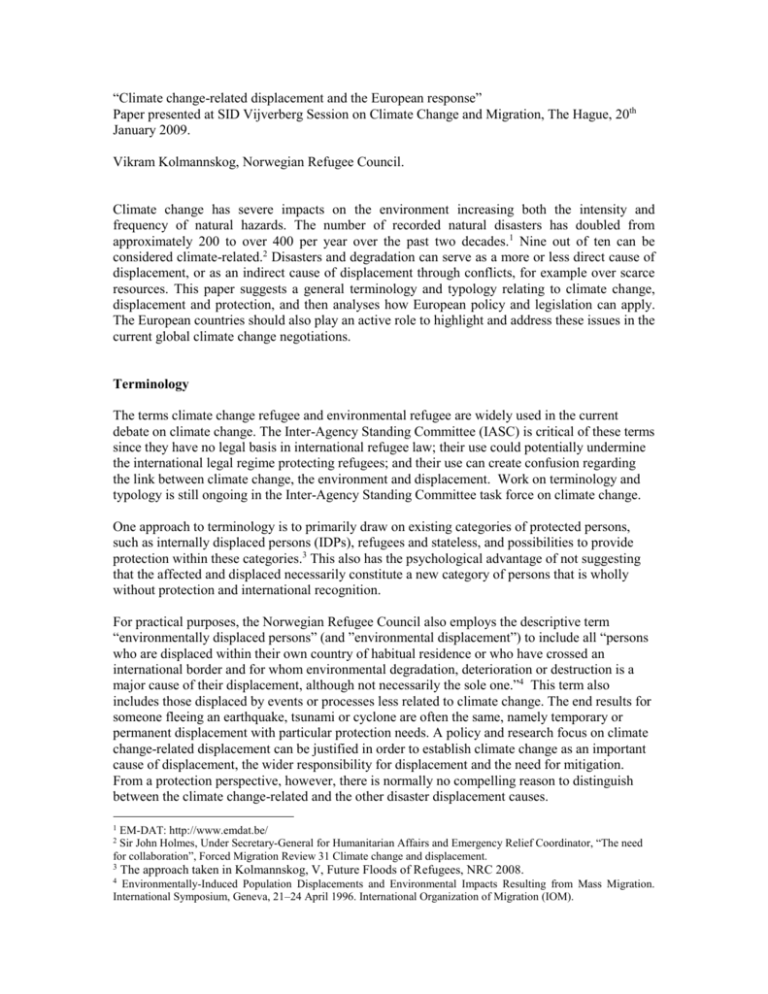
“Climate change-related displacement and the European response”
Paper presented at SID Vijverberg Session on Climate Change and Migration, The Hague, 20th
January 2009.
Vikram Kolmannskog, Norwegian Refugee Council.
Climate change has severe impacts on the environment increasing both the intensity and
frequency of natural hazards. The number of recorded natural disasters has doubled from
approximately 200 to over 400 per year over the past two decades.1 Nine out of ten can be
considered climate-related.2 Disasters and degradation can serve as a more or less direct cause of
displacement, or as an indirect cause of displacement through conflicts, for example over scarce
resources. This paper suggests a general terminology and typology relating to climate change,
displacement and protection, and then analyses how European policy and legislation can apply.
The European countries should also play an active role to highlight and address these issues in the
current global climate change negotiations.
Terminology
The terms climate change refugee and environmental refugee are widely used in the current
debate on climate change. The Inter-Agency Standing Committee (IASC) is critical of these terms
since they have no legal basis in international refugee law; their use could potentially undermine
the international legal regime protecting refugees; and their use can create confusion regarding
the link between climate change, the environment and displacement. Work on terminology and
typology is still ongoing in the Inter-Agency Standing Committee task force on climate change.
One approach to terminology is to primarily draw on existing categories of protected persons,
such as internally displaced persons (IDPs), refugees and stateless, and possibilities to provide
protection within these categories.3 This also has the psychological advantage of not suggesting
that the affected and displaced necessarily constitute a new category of persons that is wholly
without protection and international recognition.
For practical purposes, the Norwegian Refugee Council also employs the descriptive term
“environmentally displaced persons” (and ”environmental displacement”) to include all “persons
who are displaced within their own country of habitual residence or who have crossed an
international border and for whom environmental degradation, deterioration or destruction is a
major cause of their displacement, although not necessarily the sole one.”4 This term also
includes those displaced by events or processes less related to climate change. The end results for
someone fleeing an earthquake, tsunami or cyclone are often the same, namely temporary or
permanent displacement with particular protection needs. A policy and research focus on climate
change-related displacement can be justified in order to establish climate change as an important
cause of displacement, the wider responsibility for displacement and the need for mitigation.
From a protection perspective, however, there is normally no compelling reason to distinguish
between the climate change-related and the other disaster displacement causes.
1
EM-DAT: http://www.emdat.be/
Sir John Holmes, Under Secretary-General for Humanitarian Affairs and Emergency Relief Coordinator, “The need
for collaboration”, Forced Migration Review 31 Climate change and displacement.
2
3
4
The approach taken in Kolmannskog, V, Future Floods of Refugees, NRC 2008.
Environmentally-Induced Population Displacements and Environmental Impacts Resulting from Mass Migration.
International Symposium, Geneva, 21–24 April 1996. International Organization of Migration (IOM).
Typology5
One disaster displacement scenario is that caused by sudden onset disasters. Sudden onset
disasters, such as floods and cyclones, can cause large-scale displacement, but depending on the
effectiveness of recovery efforts the ensuing displacement need not be long-term. Areas may be
designated as high-risk zones prohibited for habitation by authorities resulting in more permanent
displacement. Most of the sudden onset disaster displaced are likely to remain inside their
country. As internally displaced persons they should receive protection in accordance with the
1998 Guiding Principles on Internal Displacement.6 In disaster situations there are also instances
of people moving across international borders. In these cases there is a potential protection gap.
A second displacement scenario is that caused by environmental degradation and slow-onset
disasters, such as desertification. These are likely to be gradual processes, beginning with
voluntary movements and potentially ending in displacement. There is therefore a challenge of
determining where to draw the line between voluntary movement and forced displacement calling
for international protection. As in the case of sudden disasters, areas may be prohibited for
habitation by authorities leading to displacement, and there may be a protection gap for those
displaced to other countries.
A third scenario potentially linked to both sudden and slow-onset disasters is that resulting in
statelessness. In the extreme case of a state losing its entire territory such as in the “sinking”
island states scenario, there is a risk that its population would be rendered stateless.
A fourth displacement scenario is that linked to conflict. There is some controversy surrounding
the links of climate change and conflicts. Suffice to say here that regardless of the causes of a
conflict, those displaced internally or to other countries are protected through different
instruments such as the 1998 Guiding Principles on Internal Displacement, International
Humanitarian Law, human rights law, refugee law and complementary and temporary protection
regimes.
Finally, it is important not to overlook those who are not displaced. Some scientists argue that
climate change impacts can impoverish the vulnerable and reduce their mobility even further.7
Importantly, human rights law applies to all. This is recognised in the IASC Operational
Guidelines and Field Manual on Human Rights Protection in Situations of Natural Disaster.8
Cross-border environmental displacement and the European response
The cross-border environmentally displaced do not qualify as refugees unless they are considered
to be persecuted for one of the five recognized grounds in the 1951 Refugee Convention, namely
5
The typology presented draws on V. Kolmannskog Future Floods of Refugees, NRC, 2008, as well as Climate
change, Migration and Displacement: Who will be affected? Working paper submitted by the informal group on
Migration/Displacement and Climate Change of the IASC – 31 October 2008 to the UNFCCC Secretariat.
6 UN Doc. E/CN.4/1998/53/Add.2, available at http://www.unhchr.ch/html/menu2/7/b/ principles.htm.
7 Black, R, Kniveton, D, Skeldon, R, Coppard, D, Murata, A, and SchmidtVerkerk, K (2008), Unpublished paper prepared for DFID, quoted in Kolmannskog, V, Future Floods of Refugees,
NRC 2008.
8 IASC Operational Guidelines and Field Manual on Human Rights Protection in Situations of Natural Disaster
Available at: http://www.brookings.edu/reports/2008/spring_natural_disasters.aspx
(Last visited: 31 July 2008)
race, religion, nationality, membership of a particular social group or political opinions.9 Some
have suggested amending the 1951 Convention. But any initiative to modify the refugee
definition would risk a renegotiation of the Convention, which, in the current political context,
may result in a lowering of protection standards for refugees and even undermine the
international refugee protection regime altogether.
It can therefore be useful to explore to what extent the cross-border environmentally displaced
persons can receive protection within the legal framework of the EU, particularly the Temporary
Protection Directive10 and the Qualification Directive.11
The Temporary Protection Directive establishes temporary protection during “mass influxes” of
certain displaced persons. The term “mass-influx” refers to situations where masses of people are
suddenly displaced and where it is not feasible to treat applicants on an individual basis. It was
decided that “mass-influx” was to be defined on a case-by-case basis by a qualified majority of
the Council. Article 2 (c) lists persons that “in particular” qualify for temporary protection; it does
not provide an exhaustive list. Arguably, if a majority decides that a natural disaster calls for
invoking the Temporary Protection Directive mechanisms, it is free to do so. It also remains to be
seen how individual Member States practice develops. There is already an interesting
interpretation of the directive in a press release from former UK Home Office Minister Des
Browne:
The Directive that we are implementing will ensure that each European Member State
plays its part in providing humanitarian assistance to people forced from their homes
by war and natural disasters and will enable a quicker coordinated response to prevent
human suffering.12
Finland and Sweden are examples of countries that on their own initiative extend temporary
protection in disaster displacement cases. According to The Finnish Aliens Act, “temporary
protection may be given to aliens who need international protection and who cannot return safely
to their home country or country of permanent residence, because there has been a massive
displacement of people in the country or its neighbouring areas as a result of an armed conflict,
some other violent situation or an environmental disaster.”13 The travaux preparatoires
emphasise that the first alternative in environmental disasters is internal flight and international
9
Article 1 A (2) of the Convention relating to the Status of Refugees, Adopted on 28 July 1951 by the United Nations
Conference of Plenipotentiaries on the Status of Refugees and Stateless Persons convened under General Assembly
resolution 429 (V) of 14 December 1950
10 Council Directive 2001/55/EC of 20 July 2001 on minimum standards for giving temporary protection in the event
of a mass influx of displaced persons and on measures promoting a balance of efforts between Member States in
receiving such persons and bearing the consequences thereof, hereafter ‘the Temporary Protection Directive’.
11 Council Directive 2004/83/EC of 29 April 2004 on minimum standards for the qualification and status of third
country nationals or stateless persons as refugees or as persons who otherwise need international protection and the
content of the protection granted’ hereafter ‘the Qualification Directive’
12 'Uk Plans In Place To Protect Victims Of Humanitarian Disasters. Press release', 1 (UK Home Office 2004), at
http://press.homeoffice.gov.uk/press-releases/Uk_Plans_In_Place_To_Protect_Vic?version=1 [accessed 8 August
2008]
13 Section 109 Temporary protection (1). English version of the Finnish Aliens Act is available at
http://www.migri.fi/download.asp?id=Aliens+Act;1220;{7DE0B313-A3EA-4EE1-B90A-1E6D8E42E0A1}
The travaux preparatoires of the Aliens Act are available at:
http://www.eduskunta.fi/triphome/bin/thw/?${APPL}=akirjat_ru&${BASE}=akirjat_ru&${THWIDS}=0.53/12160379
33_449564&${TRIPPIFE}=PDF.pdf
From page 183 you find the text concerning subsidiary protection and from page 197 temporary protection.
humanitarian help, but acknowledge that mass influx may occur and temporary protection may be
necessary.
According to Article 2 (e) of The Qualification Directive,14 an applicant, who does not qualify for
Convention refugee protection, may receive subsidiary protection if it is considered that the
applicant faces “a real risk of suffering serious harm.” Although the drafters departed somewhat
from a human rights approach, the current Article 15 defining serious harm, is still partly based
on the European Convention of Human Rights with inter alia the right to life (Article 2) and the
ban on torture, inhuman or degrading treatment or punishment (Article 3). Drawing on recent
European case-law such as “Budayeva vs. Russia”,15 it could be argued that subsidiary protection
could be granted in certain cases of extreme natural disaster or degradation.
A discussion note from the Commission preparing the ground for the creation of a subsidiary
protection regime challenged Member States on whether “environmental disasters” should be a
ground for subsidiary protection.16 There are few traces in the official documents detailing how
the Member States responded to this proposal. The European Parliament claiming that crossborder environmental displaced persons equally need protection and that there is an urgent need
to devise the appropriate instruments and policies of prevention, suggested that should provide
step two of a Common European Asylum Policy.17 The ongoing amendment process of the
Qualification Directive outlined in the Policy Plan on Asylum of the 17th June last year is an
opportunity to amend Article 15 to better address the protection gap. The Finnish and Swedish
legislation and case-law should be looked more into to see whether it could serve as best-practice
or even a model for a new sub-paragraph, thereby explicitly recognising environmentally
displaced persons.
According to the Finnish Aliens Act, “aliens residing in the country are issued with a residence
permit on the basis of a need for protection if […] they cannot return because of an armed conflict
or environmental disaster.”18 We find a similar provision in the Swedish Aliens Act, which
includes in the category “others in need of protection” foreign nationals who cannot return to
their home country because of an environmental disaster.19 The Swedish travaux preparatoires
emphasise that natural disasters will normally result in a temporary need for protection, but they
also mention longer-term disaster scenarios such as the “sinking” islands and the need for
international burden-sharing and durable solutions.20
Other countries may not have an explicit recognition of cross-border disaster displacement in
their legislation, but still have an inclusive practice of temporary, complementary or humanitarian
protection. Currently the Danish Ministry of Refugees, Immigrants and Integration is developing
a policy on climate change and displacement. Although the main focus is on the most affected
regions, the question of what should happen to those who come to Denmark is also addressed.
There is already some interesting Danish practice on humanitarian asylum.21 In particular cases,
14
Dir 2004/83/EC
15
Case of Budayeva and others v. Russia, 15339/02, 21166/02, 20058/02, 11673/02 and 15343/02, Judgment of 30
March 2008
16
Council (1999a). Discussion paper on subsidiary protection, Asile 41. Brussels, Council of the European
Union: 6.
17
PE 319.971 A5-0333/2002
Section 88 Need for protection (1).
19 Chapter 4 Refugees and others in need of protection 2 § nr. 3. English version of the Swedish law is available at
http://www.sweden.gov.se/content/1/c6/06/61/22/fd7b123d.pdf
20 See SOU 1995:75 page 147
21 Aliens Act § 9 b, 1, Udlændingeloven, law nr. 826 of 24. august 2005.
18
humanitarian asylum has been granted single women and families with young children from areas
where the living conditions are considered to be extremely difficult, for example due to famine.
This is known as the survival criteria.22 From 2001 to 2006 there was actually a presumption that
families with young children should not be returned to Afghanistan due to the drought. This
practice was adjusted and eventually included landless people who came from areas where there
was a lack of food and who would be in a particularly vulnerable position upon return.
At a minimum, the human rights principle of non-refoulement may provide some basic protection
against return in the other European countries.23 In some cases people simply cannot return such
as when the place no longer exists as in the “sinking” island states scenario. Even in less extreme
situations, livelihood and quality of life considerations may dictate that people cannot reasonably
be expected to return to the place they came from. Article 21, sub-paragraph 1, of the
Qualification Directive reiterates the commitment to non-refoulement. There are some examples
of the application of non-refoulement or similar considerations of a “softer”, discretionary
character in situations of natural disaster. In the aftermath of the tsunami in 2004 “UNHCR’s call
for suspension of return to the areas affected by the December 2004 tsunami, though not based on
a legal obligation, was well respected.”24 Best practice on cross-border environmental
displacement could also be recommended globally, through the European countries’ voices in the
climate change negotiations.
The potential of adaptation and the European response
There is also an international obligation to prevent arbitrary displacement in the first place.25
Climate change does not necessarily lead to displacement. Adaptation measures reduce the
impacts of climate change and thus also the need to move. Climate change impacts will also
increase the need for local, national as well as international humanitarian response significantly.
The displacement due to disasters need not be too long and painful if humanitarian response and
recovery efforts are effective. Most of the environmentally displaced persons in the near future
are likely to remain within their country of origin or region, thus making complementing EU
external strategies important in order to tackle environmental displacement. The EU can also
strengthen its adaptation assistance in the external dimension. There is a need for comprehensive
understanding of adaptation, including disaster risk reduction and humanitarian response. The
European countries should also strive to have this acknowledged in the climate change
negotiations.
At the same time as we stress the importance of adaptation, we must remember that there are
limits to adaptation. We cannot adapt to the more extreme climate change. Therefore climate
change mitigation to limit the increase in temperature to 2 degrees above pre-industrial level is a
must. But even with this goal, some low-lying island states have started preparing for the scenario
of their states ceasing to exist because of sea level rise. Pre-emptive migration is also a
phenomenon and possible solution which must be looked into. Some adaptation funding could be
” Der kan i helt særlige tilfælde gives humanitær opholdstilladelse til enlige kvinder og familier
med mindre børn fra områder, hvor der efter ministeriets opfattelse hersker ekstremt vanskelige
levevilkår, f.eks. som følge af hungersnød eller som følge af helt uforudsigelige forhold
(overlevelseskriteriet)..”
http://www.nyidanmark.dk/resources.ashx/Resources/Lovstof/Praksisnotater/2006/Notat_9bpraksis_november2005.pdf
22
23
V. Kolmannskog, 'Future floods of refugees: A comment on climate change, conflict and forced
migration', in Vikram Odedra Kolmannskog (ed) (Norwegian Refugee Council, 2008).
ExCom (2005). ‘Providing International Protection Including Through Complementary Forms of
Protection.’ Refugee Survey Quarterly 25(1)
24
25
This recognition has manifested itself in principle 5 in the Guiding Principles on Internal Displacement.
used to better enable populations in high-risk areas for labour migration through for example
education and training in attractive skills and professions, and labour immigration programmes
could give them priority. Developing immigration agreements with third countries that are most
likely to be negatively affected by climate change must be done in partnership to avoid brain
drain and other negative effects. Carried out correctly, expansion of legal labour migration to
European states could assist most affected countries and enhance protection of the individual, as
well as supply Europe with a much needed work force. Such measures could form part of the
“comprehensive European Migration Policy” where the EU aims to deal “with migration in the
overall socio-economic context of Europe.”26
POLICY RECOMMENDATIONS
1) A guiding principle for adaptation is that States give priority to the particular needs of the
people most vulnerable to and the people most affected by climate change, including the
displaced and those at risk of displacement.
2) States should respect and ensure respect for their obligations under international law,
including human rights and humanitarian law, in all circumstances, so as to prevent and
avoid conditions that might lead to displacement of persons.27 This obligation should be
fully respected in adaptation and mitigation efforts. A rights approach is needed in all
work on climate change.
3) Adaptation could include better enabling populations in high-risk areas for labour
migration through for example education and training in attractive skills and professions,
as well as addressing them in labour immigration programmes.
4) Many displaced persons are already included in existing categories of protected persons,
such as internally displaced persons (IDPs), and they need be made more visible and
recognised within the categories. States could draw upon the 1998 Guiding Principles on
Internal Displacement in their policy and legislation.
5) If refugee status is deemed inapplicable in situations of cross-border displacement, States
should still ensure that migration management systems provide for the entry and
protection of those in need.
6) If return is not possible or reasonable due to circumstances in the place of origin and
personal conditions including particular vulnerabilities, a person should receive either
temporary or complementary/subsidiary protection. Best practice could be recommended
here.
Commission, E. (2007a). ‘A Comprehensive European Migration Policy.’ Retrieved 1 August, 2008,
from http://europa.eu/rapid/pressReleasesAction.do?reference=MEMO/07/188
26
27
This recognition has manifested itself in principle 5 in the Guiding Principles on Internal Displacement. The Hyogo
Framework for Action 2005-2015 affirms that “states have the primary responsibility to protect the people and property
on their territory from hazards and […] to give high priority to disaster risk reduction in national policy, consistent with
their capacities and resources available to them” (Hyogo Framework for Action 2005-2015, World Conference on
Disaster Reduction, UN Doc. A/CONF.20/L.3/Rev.1, para. 4).
